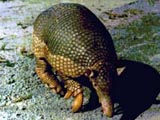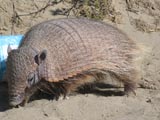Armadillos: Biology, Ecology and Images
Biologists like to classify living organisms into logical, related groups. (We can't help it - it's how we were trained!) This site is no different, but I do recognize that the names of individual armadillo species are probably meaningless to many of my visitors. To help make sure every visitor can find what he or she is looking for, the armadillo groups on this website are linked both by common name and by scientific name, here and in the navigation menu at the top of each page. If you want to browse by common name, use the links below. If you would like to look up a particular species, go to the tree at the bottom of this page. Both sets of links will take you to the same place.
If you can't find the armadillo you are looking for by common name or by scientific name, try the Armadillo Pictures page for help. The Pictures page does not contain all the images available, but it does have a few of the photos that can be found below. Each set of photos is linked back to the Species page for that armadillo.
Armadillos: Listed by common name
- Nine-banded or Long-nosed Armadillos
-
Genus Dasypus: The only armadillo found in the United States
(Six species) - Giant Armadillo
-
Genus Priodontes: The largest armadillo
(One species) - Hairy Armadillos
-
Genus Chaetophractus
(Three species) - Six-banded Armadillo
-
Genus Euphractus
(One species) - Pink Fairy Armadillo
-
Genus Chlamyphorus: The smallest armadillo
(One species) - Greater Fairy Armadillo
-
Genus Calyptophractus
(One species) - Three-banded Armadillos
-
Genus Tolypeutes: The only armadillos that can roll up in a ball
(Two species) - Naked-tailed Armadillos
-
Genus Cabassous
(Four species) - Pichi or Dwarf Armadillo
-
Genus Zaedyus
(One species)
Armadillos: Listed by scientific name
The following phylogenetic tree is shared by all armadillos. Scientists use a set of rules to name all living things, based upon the relationship between the organisms. The science of naming organisms is known as taxonomy.
- Armadillo Taxonomic Tree
-
- Kingdom Animalia: Animals
- Phylum Chordata: Chordates
- Subphylum Vertebrata: Vertebrates
- Class Mammalia: Mammals
- Subclass Eutheria: Placental mammals
- Order Cingulata (Formerly Xenarthra): Armadillos, sloths & anteaters
- Family Dasypodidae: Armadillos
- Order Cingulata (Formerly Xenarthra): Armadillos, sloths & anteaters
- Subclass Eutheria: Placental mammals
- Class Mammalia: Mammals
- Subphylum Vertebrata: Vertebrates
- Phylum Chordata: Chordates
- Kingdom Animalia: Animals
Within the family Dasypodidae, there are twenty officially recognized species in nine genera. To see detailed information and photographs of a particular species, click the name of the species that interests you. You may also click the name of a genus to browse the information on the species included. Pictures are present for species marked with an asterisk (*).
- Armadillo Species
-
- Family Dasypodidae: Armadillos
- Subfamily Chlamyphorinae
- Genus Calyptophractus: Greater fairy armadillo
- Genus Chlamyphorus: Pink fairy armadillo
- Subfamily Dasypodinae
- Genus Cabassous: Naked-tailed armadillos
- Genus Chaetophractus: Hairy armadillos
- Genus Dasypus: Long-nosed armadillos
- Genus Euphractus: Six-banded armadillo
- Genus Priodontes: Giant armadillo
- Genus Tolypeutes: Three-banded armadillos
- Genus Zaedyus: Pichi
- Subfamily Chlamyphorinae
- Family Dasypodidae: Armadillos
 ] will leave this website.
] will leave this website.








